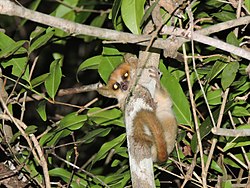Career
Rakotosamimanana's work in the Department of Geology, from the first included supervising and teaching practical aspects of the subject. [2] After seven years, she and her colleague Professor Henri Rakotoarivelo, set up the university's first palaeontology service in 1974. [2]
In 1977 she was awarded a doctorate from University of Paris VII, entitled "La diversité anthropologique des isolats des hautes terres de l'Imerina (Madagascar). Confrontation du biologique et du social". [3] This research examined diversity of people and species and their interactions in the Imerina Highlands. [1]
In 1993, the palaeontology service became a full Department, mostly due to her initiatives, and she was head of it from 1995-1998. [1] She created also created three new departments: Physical Anthropology, Nutritional Anthropology, Primatology and Evolutionary Biology. [2] She was active in the department until 2003 and supervised doctoral students until her death. [1]
Throughout her career Rakotosamimanana was a member of several professional bodies, including the "Groupe d'Etude et de Recherche sur les Primate de Madagascar" (GERP). [2] Other organisations she was involved with include: Malagasy Academy, "Ranomafana National Park" project, IUCN / SSC Primate Survival Commission, the editorial Board of "International Journal of Primatology" and "Lemur News", Society of Human Biometrics, Society of Anthropology of Paris and the International Association of Anthropologists. [1]
After the financial crisis in Madagascar in the 1980s, Rakotosamimanana was one of the architects to negotiate for foreign conservation NGOs to instigate programmes, which were to be truly beneficial to the development of the country. [4] As Secretary-General of the 17th Congress of the International Primatological Society, Rakotosamimanana persuaded the government to provide significant funding for the university as preparation for the 1998 conference, which was hosted in Antananarivo. [4] From 1977-83 she was Director of Scientific Research at the Malagasy Ministry for Education and Scientific Research. [2] From 1986-92 she was a technical adviser to the same ministry. [2] She was an active agent in the creation of Madagascar's National Environmental Action Plan. [5]
This page is based on this
Wikipedia article Text is available under the
CC BY-SA 4.0 license; additional terms may apply.
Images, videos and audio are available under their respective licenses.



